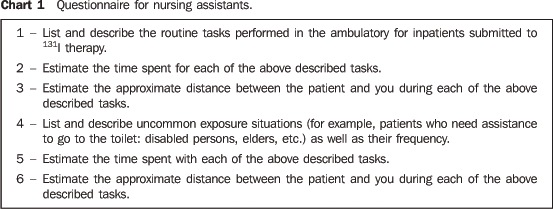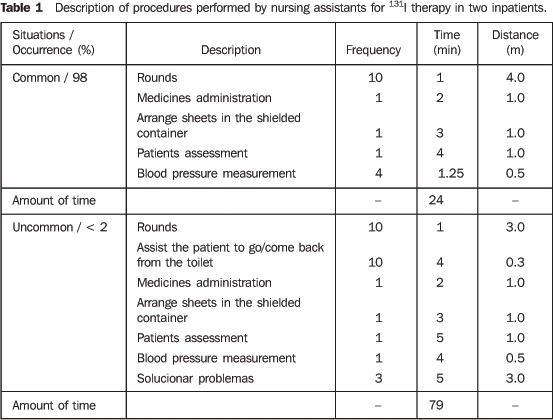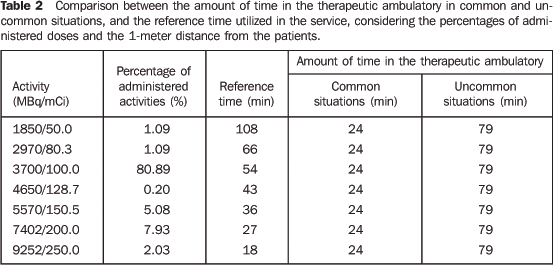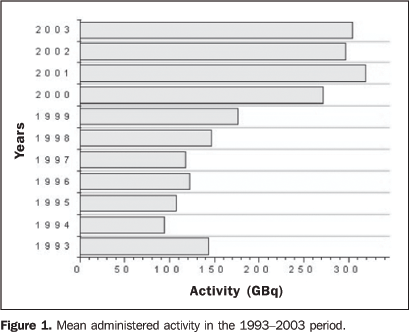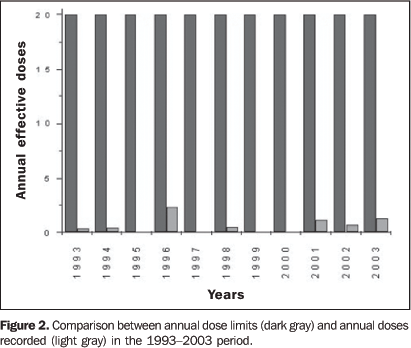Radiologia Brasileira - Publicação Científica Oficial do Colégio Brasileiro de Radiologia
AMB - Associação Médica Brasileira CNA - Comissão Nacional de Acreditação
 Vol. 40 nº 4 - July / Aug. of 2007
Vol. 40 nº 4 - July / Aug. of 2007
|
ORIGINAL ARTICLE
|
|
Occupational exposure of nursing staff working with radioiodine therapy during 11 years |
|
|
Autho(rs): José Ulisses Manzzini Calegaro, Sandra Mara Pessano Teixeira |
|
|
Keywords: Occupational exposure, Effective dose, External individual monitoring, Iodo-therapy |
|
|
Abstract:
IMD, Head for the Centro de Medicina Nuclear do Hospital de Base do Distrito Federal, Secretaria de Estado de Saúde, Brasília, DF, Brazil
INTRODUCTION In the last decade, total thyroidectomy has been adopted as aninitial modality for management of differentiated thyroid cancer,contemplating its variable multicentricity. The 131Iablation of the remaining tissue allows the utilization ofsuppressive hormone therapy to avoid the proliferation of furtherresidual nuclei of cancerous cells, as well as to follow-up theprogress of the disease through the serum levels ofthyreoglobulin(1). For these reasons, there hasbeen a considerable increase in the utilization of131I as complementary therapy. Some routine procedures are performed by nursing assistantswho attend to one or two inpatients during the 131Itherapy, and therefore they are exposed to radiation emissionsfrom these patients. This exposure is variable according to thenumber of inpatients, procedures performed, the distance keptfrom the patient, and amounts of time in the ambulatory. The present study is aimed at evaluating the exposurecircumstances and effective doses to nursing assistants involvedin the administration of 131I therapy in the periodbetween 1993 and 2003, with two types of individual monitoringdevices: dosimetric films and thermoluminescentdosimeters(2,3).
MATERIALS AND METHODS Surveys were performed to evaluate the circumstances of the radiation exposure of nursing assistants, as well as doses received while assisting inpatients submitted to 131I therapy. In order to delineate the situations where nursing assistants were exposed to radiation, a questionnaire on tasks description was elaborated to be answered by them (Chart 1). This questionnaire asked the respondents to describe their routine tasks — common situations —, and situations where patients presented some locomotion difficulty — uncommon situations. There were questions about frequency of events, distances kept, and mean amount o time in the therapy room for the each task performance, considering two inpatients, during two days. The situations description and estimates can be found on Table 1. The percentages of common and uncommon situations were estimated with basis on the service records.
The amount of time spent in tasks during patients' stays was compared with the amounts of time in the therapeutic ambulatory utilized as a reference in the service(4), considering the activities and percentages of occurrence of these radiation doses. These comparative results can be found on Table 2.
The effective doses in two consecutive periods and in two types of individual monitoring devices were compared to the required maximum limits of annual doses(5) (Figure 2). For this purpose, a survey was conducted to determine the activities involving 131I therapy in the period between 1993 and 2003 (Figure 1), and the effective dose to the three nursing assistants in charge of the inpatients (Table 3). In the period between 1993 and 1999, the individual monitoring method utilized was the dosimetric film supplied by the Laboratory of Radiological Protection of Department of Nuclear Energy – Universidade Federal de Pernambuco. In the 2000–2003 period, thermoluminescent dosimeters (Sapra Landauer Ltda.) were utilized.
Dosimetric film consist of a radiographic film utilized todifferentiate the several radiation energies, whose blackening iscaused by the incidence of ionizing radiation through severalfilters, allowing the estimation of the radiation dose receivedby the user(3). The dosimetric filmssensitivity is intermanufacturer variable, but the minimum doselimit is 0.20 mSv(2). The thermoluminescent dosimetry utilizes smalllithium-fluoride crystals where radiation deposits its initialenergy and that generate light. This is measured by aphotomultiplier tube, and the amount is utilized to estimate theradiation dose(3). Thermoluminescent dosimetersare considered as more sensitive than dosimetric films, becausetheir lower limit is about 0.10 mSv(2). In the two above mentioned periods, the nursing assistantswere given instructions regarding the main measures ofradiological protection: distance, as feasible, use of shielding(barriers or lead apron) during long-duration procedures andmaximum amount of time at a 1 meter-distance from thepatients(4). Also, instruction was given forroutine or emergency procedures not to be performed within 30minutes following the dose administration(6),and for them to avoid procedures in front of the patient,because, in this positioning, the area of exposure is larger thanin the lateral positioning(7,8). In both periods, the monitoring devices were kept in a safeplace, free from ionizing radiation. The chi-square test wasutilized for statistical data analysis.
RESULTS It could be observed that, in common situations, the meanamount of time of nursing assistants in the therapy room, isabout 24 minutes, and is within the maximum amount of timerespected by the service(4), and the percentageof patients presenting with no locomotion difficulty is 98%. Inuncommon situations, the mean amount of time in therapy room is79 minutes, a time considered as above the reference time,however, the percentage of patients presenting with locomotiondifficulty is lower than 2%, an index considered as extremelylow. In the period evaluated, the percentage of administered doseswas 80.89% for doses with 3700 MBq activity; 7.93% for doses with7400 MBq activity; 5.08% for doses with 5500 MBq activity; 4.07%for doses < 3700 MBq activity; and 2.03% for doses with 9250MBq activity. The mean number of patients submitted to iodotherapy in the 1993/1999 period was 30, while in the 2000/2003 period, 73 patients were treated per year. Thus, the mean activity of 1.30 × 105 MBq/year increased to 2.98 × 105 MBq/year, that is to say, the was a 2.3-time increase (Figure 2). In the 1993/1999 period there were ten dose records on dosimetric films, all of them at record level. M corresponds to doses < 0.20 mSv (Table 3). In the 2000/2003 period, ten doses records also were obtained with thermoluminescent dosimeters, with only one of them at the investigation level (1.30 mSv). In this case, M corresponds to doses < 0.10 mSv (Table 3). In the first period the percentage of dosimeter readings was77.6%; in the second period this percentage was 83.3%. It isimportant to consider that these are reasonable indices for thepresent study purposes. Figure 2 demonstrates that the doses records from both dosimetric systems (dosimetric film and thermoluminescent dosimeter) were very below the standard limit(5). There was no statistical significant difference between the doses recorded.
DISCUSSION The amount of time of nursing assistants in the therapeuticambulatory during common situations is within the reference timeadopted by the service(4), and the occurrenceof higher exposure (uncommon situations) is considered asnon-relevant. During the studied period, the activity of 131Iadministration doubled, however, the exposure recorded for eachnursing assistant has not presented the corresponding increase of2.3 times. The records do not demonstrate an increase in theresults from the individual monitoring performed withthermoluminescent dosimeters during the period where the activitywas doubled. It is observed that the number of dosimetricreadings was higher. In the periods evaluated, the doses to professionals wereconsidered as extremely low in relation to the limits required bythe regulations in force(5). In both types ofindividual monitoring devices the doses recorded were much belowthe standard annual limits. Thus, we have considered important toelaborate tables including the appropriate times and distancesfor the different activities of nursing assistants, allowing themanagement and reduction of the occupational exposure during theassistance to 131I therapy. It may be suggested thatservices operating with activity equivalent or lower than thosefound in the present study do not require a mandatory individualmonitoring, provided the nursing staff is given instructionsabout the amount o time in the therapy ambulatory and appropriatedistances to be kept from the patients. We emphasize therelevance of a revision in the radiological protection regulationrequirements that should be directly related to the level ofradioactive material activity as well as to the proceduresfrequency. Few studies evaluate the occupational radiation exposure ofnursing staff. One of them demonstrates the low level recorded:1.5 mSv/year(9). Other authors havedemonstrated the same finding: the radiation levels are muchbelow the permissible levels(10,11).Considering that the permissible dose limit for the generalpopulation is 1.0 mSv/year; that in certain Brazilian regions thenatural radiation level is between 7.0 and 12.0mSv/year(12); and that the radiation levelsdescribed by the present study are frequently non-relevant, itseems that the current regulation requirements are exaggerated.These considerations lead to the conclusion that an appropriateinstruction on radiological protection principles seems to beenough for the effective protection of the nursing staff involvedin the assistance to patients submitted to 131Itherapy.
CONCLUSION Occupational ionizing radiation exposure levels are low innursing assistants who have been appropriately instructed onbasic radiological protection procedures. It is possible tosuggest that the requirements of external individual monitoringmight be less stringent than in other centers where the number ofpatients is lower than in the Center of Nuclear Medicine atHospital de Base do Distrito Federal.
REFERENCES 1. Schlumberger M, Berg G, Cohen O, et al. Follow-up of low-risk patients with differentiated thyroid carcinoma: a European perspective. Eur J Endocrinol 2004;150:105–112. [ ] 2. Extracts from IAEA's Resources Manual in Nuclear Medicine. World Federation of Nuclear Medicine and Biology. World J Nucl Med 2004; 3:82–104. [ ] 3. Phelps ME, Sorenson JA. Radiation safety and health physics. In: Sorenson JA, Phelps MB, editors. Physics in nuclear medicine. 2nd ed. Philadelphia, PA: WB Saunders, 1987;537–538. [ ] 4. Riccabona G. 131I therapy for thyroid disease. Innsbruck, Austria: Ed. Oris Group, 1999;10. [ ] 5. Comissão Nacional de Energia Nuclear. Diretrizes básicas de radioproteção. Norma CNEN-NN 3.01, Resolução nº 27, 2005, pág.14, seção 5.4.2, subseção 5.4.2.1. [ ] 6. Castronovo Jr FP, Beh RA, Veilleux NM. Iodine 131 therapy patients: radiation dose to staff. Radiat Prot Dosim 1986;15:45–49. [ ] 7. Castronovo Jr FP, Beh RA, Veilleux NM. Dosimetric considerations while attending hospitalized I-131 therapy patients. J Nucl Med Technol 1982;10:157–160. [ ] 8. Andrade JR, Ferlin BL, Spiro MEB, Bernausk MEB, Pinto ALA, Bacelar A. Determinação das curvas de isoexposição em pacientes submetidos a iodoterapia. Porto Alegre, RS: Pontifícia Universidade Católica do Rio Grande do Sul, 2000. [ ] 9. Watanabe M, Ishikawa N, Ito K. Examination of occupational exposure to medical staff (primarily nurses) during 131I medical treatments. Kaku Igaku 2004;41:25–31. [ ] 10. Siekierzynski M. Problems with radiation protection for adjuvant radiotherapy of thyroid cancer. Wiad Lek 2001;54 Suppl 1:307–311. [ ] 11. Williams CE, Woodward AF. Management of the helpless patient after radioiodine ablation therapy – are we being too strict? Nucl Med Commun 2005;26:925–928. [ ] 12. Freire-Maia N. Radiogenética humana. São Paulo, SP: Edusp,1972;55–92. [ ]
Received October 30, 2006. Accepted after revision February 5, 2007.
* Study developed in the Centro de Medicina Nuclear do Hospital de Base do Distrito Federal, Secretaria de Estado de Saúde (State Secretariat of Health), Brasília, DF, Brazil. |
|
Av. Paulista, 37 - 7° andar - Conj. 71 - CEP 01311-902 - São Paulo - SP - Brazil - Phone: (11) 3372-4544 - Fax: (11) 3372-4554
